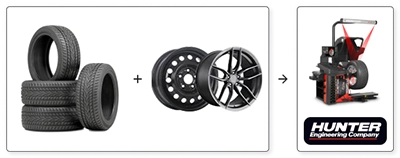Safety Tips: Opt for Winter Tires in Manitoba

Many Manitoba drivers wonder if it is essential to have winter tires. The short answer is that every driver's needs differ depending on the weather and road conditions they encounter. Still, winter tires are generally highly recommended in this province, where temperatures are shallow, and snowfall is frequent.
Using winter tires can go a long way to making winter driving safer, so it's no wonder most insurance companies recommend them. In Manitoba, some companies even give a discount on insurance for the installation of winter tires!
Benefits of winter tires
Winter tires are designed to be used in harsh winter conditions. Snow and ice reduce a vehicle's grip on the road, making stopping and turning much more difficult. Winter tires provide better traction than other tires, especially in poor conditions and when temperatures drop below 7 degrees Celsius.
Winter/snow tires are easily identified by a three-peak mountain and snowflake symbol on the tire's sidewall (3PMS). This symbol certifies that the tire meets or exceeds the snow traction standards set by Transport Canada and the tire industry.
Studless winter tires have numerous slits in the tread that act as biting edges and a tread compound that remains flexible and more suitable for cold temperatures. Studded models offer good traction on snow and can be studded for better grip on ice.
For safer winter driving, make sure that at least 50% of the tread on your winter tires is still present. A qualified professional should inspect the tires to ensure they are reliable and in good enough condition for use.
What about all-season tires?
All-season tires are made with a different type of rubber than winter tires. It holds well until temperatures drop below 7 degrees Celsius, where it hardens and reduces traction. Winter tires are built to withstand extreme weather conditions.
Always remember that winter driving in Manitoba is challenging.
Some tips for winter driving in Manitoba
When driving in winter, the first thing to do is reduce your speed. This applies whether the weather is clear, rainy, foggy or snowy. Proper speed will help you control slippery roads.
It is imperative to increase your safe distance from other vehicles. The average reaction time is 2 seconds. How do you check if you are at the proper length? When the vehicle in front of you reaches a landmark (signs, traffic lights, etc.), say "cro-co-dile" at average speed. If you don't have time to say it, increase your distance from the vehicle in front of you.
We recommend that you check the road conditions before you leave. For the most current road conditions, visit manitoba 511
If driving becomes too risky, turn around or find a safe place to stop until conditions improve.
It is essential to check your tire pressure regularly. Especially if you plan to drive on a highway, good quality, adequately inflated winter tires in good condition will give you the best traction possible and reduce your vehicle's fuel consumption on the winter road.
Most importantly, slow down, be cautious and adapt your driving to the prevailing conditions, no matter where you are in Manitoba.


